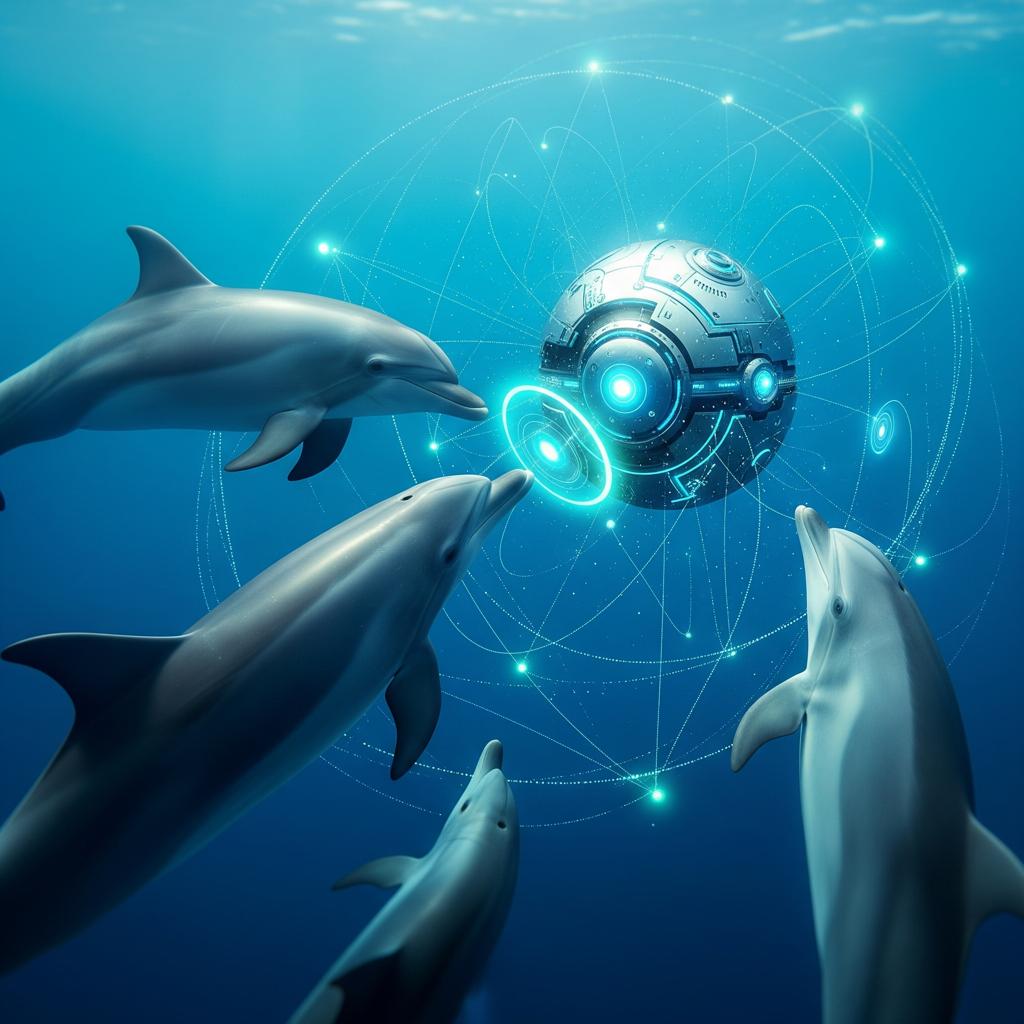
DolphinGemma: Can Humans Talk to Dolphins?
Dolphins have been fascinating humans for centuries, inspiring stories, myths, and scientific interest. Their intelligence, sociality, and advanced communication skills have led scientists to ask one profound question:
Can humans talk to dolphins?
Enter DolphinGemma, an ambitious project to bridge the communication divide between humans and dolphins. This article explores the history, technology, science, and future prospects of DolphinGemma in a bid to talk to dolphins.
Be careful not to confuse DolphinGemma, a project for communicating with dolphins, with the Google LLM project of the same name, which you can find here.
Understanding Dolphins: The Basis of Communication Research
Prior to discussing DolphinGemma, it is necessary to gain an understanding of the nature of dolphins and why researchers are so keen to crack their code.
Dolphin Intelligence and Social Structure
Dolphins, mainly bottlenose dolphins (Tursiops truncatus), are known for their high intelligence. Research indicates they have big brains for their body size and show problem-solving abilities, self-awareness (they pass the mirror test), and elaborate social structures with cooperation and alliances.
Dolphin Communication Systems
Dolphins communicate using a variety of sounds, including clicks, whistles, and body language:
- Clicks: Primarily for echolocation for navigation and hunting.
- Whistles: Thought to be signature whistles unique to each dolphin, serving as identifiers for individuals.
- Body Language: Breaching, tail slapping, and postures also communicate social information.
Despite decades of research, scientists have yet to parse the grammar or meaning of dolphin communication, though new developments in bioacoustics and machine learning are providing some traction.
The Origins of DolphinGemma
DolphinGemma is a project that was conceived with the vision to create a usable interface to facilitate two-way communication between dolphins and humans. "DolphinGemma" is a "gem" or treasure in the knowledge about the language of the dolphin.
Founding Vision
The project was launched in the late 2010s as a collaboration of marine biologists, linguists, engineers, and AI specialists. Its mission: to use modern technology to translate dolphin noises into the human language and enable dolphins to respond in a way audible to humans.
Main Objectives
- To decode the acoustic patterns of dolphin noises.
- To develop an AI-based translator of dolphin language.
- To develop a user-friendly device that enables interactive communication.
- To promote conservation awareness through enhanced human-dolphin relationships.
Technology Behind DolphinGemma
DolphinGemma combines various state-of-the-art technologies to decode and interpret dolphin communication signals.
Bioacoustic Data Collection
First, it involves collecting extensive amounts of audio data from dolphins in their natural environment and controlled environments. Hydrophones (underwater microphones) record sounds in various social contexts: feeding, mating, socializing, and warning calls.
Machine Learning Algorithms
Machine learning algorithms, with the help of large datasets, recognize and classify patterns in dolphin vocalizations. The algorithms employ the following techniques:
- Neural Networks: For recognizing complex acoustic patterns.
- Clustering Algorithms: For grouping similar vocalizations that could have specific meanings.
- Natural Language Processing (NLP): Adapted for dolphin vocalizations to interpret sequences and possible syntax.
Real-time Translation Interface
DolphinGemma integrates the AI models into a handheld device with underwater microphones and speakers. The interface allows researchers and enthusiasts to "communicate" with dolphins and receive translated responses in near real-time.
Challenges in Technology
- Acoustic Complexity: Dolphin vocalizations are very varied and might overlap in noisy underwater environments.
- Contextual Interpretation: Interpreting the meaning of sounds requires knowledge of behavioral context, which AI cannot interpret to a certain degree.
- Ethical Considerations: Ensuring that interaction will not harm or stress dolphins.
Scientific Basis for Dolphin Communication
While DolphinGemma is a novel project, dolphin communication has a basis in decades of scientific research.
Milestones in Previous Research
- John C. Lilly's Work (1960s-70s): Lilly was among the first to attempt communicating with dolphins through underwater keyboards and tape-recording dolphin whistles.
- Finding of Signature Whistles (1980s): Researchers found dolphins have unique whistles as "names" or identifiers.
- Playback Experiments: Scientists played recorded sounds back to dolphins and observed responses, demonstrating dolphins could recognize and imitate human-created signals.
- AI and Acoustic Pattern Analysis (2000s-present): As computing has become more advanced, researchers have increasingly utilized AI to analyze dolphin sounds and social behavior.
Why Dolphins Are Good Candidates for Communication
- High cognitive abilities.
- Complex social interactions.
- Utilization of vocal learning, so dolphins are able to imitate and learn new sounds.
- Evidence of referential signaling (communication about objects or individuals through sounds).
Potential Uses of DolphinGemma
Scientific Research and Understanding
- Providing unprecedented insight into the cognition and culture of dolphins.
- Enabling longitudinal study of how communication develops in dolphin populations.
Marine Conservation
- Raising awareness of dolphins' intelligence and social needs.
- Assisting in the monitoring and protection of vulnerable groups through better understanding of their distress calls or needs.
Education and Eco-tourism
- Creating interactive experiences for the public.
- Promoting empathy and engagement with marine animals.
Therapeutic and Recreational Use
- Dolphin-assisted therapy has been popular but also controversial; better communication could assist in furthering its methodology.
- Promoting respectful, ethical human-dolphin interaction.
Ethical and Environmental Considerations
The quest to communicate with dolphins is accompanied by important ethical responsibilities.
- Animal Welfare: Interaction should not cause stress or disruption to natural behavior.
- Conservation Priority: Projects like DolphinGemma should support conservation goals, not exploit dolphins for entertainment.
- Data Privacy for Wildlife: Just as humans have a right to communication privacy, it is only right to respect natural wildlife rhythms.
Future of DolphinGemma and Marine Communication
Increasing AI Capabilities
As AI advances, DolphinGemma could develop beyond basic translations into full conversation exchanges.
Integration with Other Marine Animals
Future research can create analogous technology for whales, seals, or other intelligent marine mammals.
International Collaboration Efforts
Large-scale marine communication databases and open science can assist in accelerating breakthroughs.
Enhancing Human Understanding of Nature
Lastly, projects like DolphinGemma are reflective of the desire of humans to understand and coexist with nature more effectively.
How to Follow and Support DolphinGemma
For researchers and fans tracking DolphinGemma, it is important to stay updated through official channels and support ocean conservation.
- Monitor research updates and publications by marine biology organizations.
- Support dolphin conservation groups.
- Engage with ethical eco-tourism that respects marine wildlife.
DolphinGemma represents a thrilling new horizon in the quest to communicate with dolphins, wedding cutting-edge technology to decades of scientific research. Despite the obstacles that remain, the project stands to revolutionize the manner in which humans engage with and learn about the ocean's most social and intelligent inhabitant. In closing the communications divide, DolphinGemma not only advances science but also deepens the human connection to the natural world, advancing the urgent cause of protecting and loving marine life.
References and Further Reading
- Janik, V. M., & Sayigh, L. S. (2013). Communication in bottlenose dolphins: 50 years of signature whistle research. Journal of Comparative Physiology A, 199(6), 479-489. https://doi.org/10.1007/s00359-013-0808-0
- Herman, L. M. (2017). The dolphin's "language": A review of vocal communication research. Marine Mammal Science, 33(2), 334-357.
- National Oceanic and Atmospheric Administration (NOAA) — Dolphin Communication and Behavior: https://www.fisheries.noaa.gov/feature-story/communication-dolphins
- Marino, L., et al. (2007). Cetaceans Have Complex Brains for Complex Cognition. PLoS Biology, 5(5), e139.









